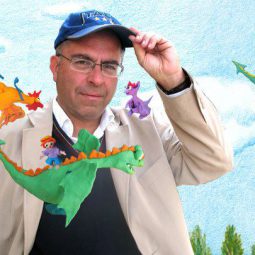
What Is Hyphal Learning?
Hyphal learning is like regular school learning, except that it’s very different. In regular learning you go from here to there. In hyphal learning you go from here to anywhere, asking your own questions, having fun exploring and discovering along the way.
2

Hyphal thinking celebrates the journey, not the destination. In hyphal learning the teacher becomes the tour guide, the mentor, while the students are busy teaching themselves and each other.
4

I’m guessing that hypha is connected to the word hyphen. Are you surprised?
Origin
early 17th century: via late Latin from Greek huphen ‘together’, from hupo ‘under’ + hen ‘one’.
6
hypha (n.)
7
When a fungus spore cell lands on, say an orange, it may start to divide and grow. At some stage it may send out hyphae (exploratory elongated cells) to discover new territories and exploit the surroundings for the benefit of the colony.
8
Hyphae are multicellular appendages that spread out from certain microorganisms, heading out to discover new territories. They create nodes from which multiple hyphae set out to discover the surroundings. The goal is to secrete substances that can help the cell survive and thrive.
9
Hyphal learning develops from a core idea or object, and spreads in any and every direction. There is no end point, no goal to be reached, no question to be correctly answered. It is based on passion, curiosity, exploration and discovery, rather than problem solving. Regular learning arrives at a singular point. It has a ‘destination’. Hyphal learning starts out a singular point and branches out.
10
In hyphal learning you can learn anything, rather than something. You then delve deeper into the discoveries of your choice.
11
Hyphal learning is similar to getting lost on Wikipedia, starting with a specific entry, then going from hyperlink to hyperlink, discovering information that you didn’t know you didn’t know, landing on entries that are so interesting and multifaceted that they themselves turn into nodes that then become the starting points for new exploration.
12
Hyphal learning is like hyphal travel. You land somewhere where you have no itinerary and allow yourself to get lost until you find something of interest. You follow your interest to another interest. You stay longer in areas of interest and discovery and then proceed where your intellect and curiosity lead you.
13
Students will assimilate what they have learned, because they have become the question askers, the explorers. The same way we remember the projects we worked on by ourselves in school, but not the material we needed to study for the exams.
14
As a facilitator of hyphal learning, the ‘teacher’ becomes a mentor, a facilitator who must be much more than a purveyor of information, facts and knowledge. When we teach students information, we imply to them that we are at the end of the journey. If two plus two equals four, it cannot equal 11 or anything else (it can, by the way). There is nowhere to go. End of the journey. No time-wasting questions, please. Next piece of information to learn.
15
In hyphal learning, you choose a place to start. It could be a physical entity. I often like to start with a banana or chocolate or yogurt or honey. Today someone wants to start with a dried fig. That’s fine too.
16
So one of the students likes/hates/wonders about dried figs. What questions can the students ask about a fig? Why is it dry? How dry? How does it dry out? Why is it called a fruit? What country does it come from? Why is it sweet? How does it start out (with a wasp, that could be a node in itself)? What happens when you eat one? Can you survive on figs? What animals eat them? What can you cook with it?
17
Can you grow a fig tree from a dried fig? Do figs float? Can you turn a fig into a musical instrument? What happens when you mix figs with concrete? Where does the word ‘fig’ come from? Why does fig have other meanings? These are just a few ideas, trust me, kids will come up with better ones of their own.
18
Following the initial question gathering the students set out on expeditions of their own. Students create discussions, write, experiment, draw, sing, paint, discover. They can present their discoveries (dissemination). They can create nodes of their choice (for example, Turkey) which then become foci for deeper delving, and then they can continue their discovery from there.
19
In hyphal learning the teachers become tour guides, facilitators, leaders, followers. The children can involve their family, friends (joint nodes), community, even government.
20
Classes can construct their own hyphal maps, delineating where they started out, the nodes along the way, and the subjects, concepts and hypotheses explored. Mindmaps of their exploration.
21
Look at part of the definition of the word classroom from Wikipedia:
… The classroom provides a space where learning can take place uninterrupted by outside distractions.
Looks like we need a new definition for that too….
Something like a place where students and mentors can get distracted…together.
22
In Hebrew:
23
24
25
Published: Jan 11, 2020
Latest Revision: Feb 17, 2020
Ourboox Unique Identifier: OB-712276
Copyright © 2020








